Top dressing is a great way to repair damaged lawn areas, smooth out uneven spots, and amend poor soil.
What Is Lawn Top Dressing
Top dressing is the process of spreading a thin layer of material (usually compost, screened loam, or sand) over your lawn, or sections of your lawn. This layer is only about a 1/4″ and is meant to be thin enough so that existing grass can grow through the freshly applied material.
Top dressing is done for a variety of reasons which include improving soil conditions and drainage, leveling and smoothing out uneven spots, and creating a layer for seed to germinate.
Best Material for Top Dressing Lawn
Choosing the right material for top dressing will depend on what you are trying to achieve:
*Compost- Compost is a great top dressing material if you’re looking to overseed and repair damaged or thin areas of your lawn. It’s also a great choice for improving soil drainage and adding nutrients to your soil, especially if you have clay soil. It’s even more effective in improving soil conditions if done right after Core Aerating. This allows the compost to work its way deeper into the soil. A lot of lawns that look hopeless can be turned around just by core aerating, top dressing with compost, and then overseeding.
*Sand- Sand is the ideal choice if you’re trying to get a very level lawn. Maybe you have some mild bumpy spots you’re looking to smooth out, or a mole pushed some tunnels up and made the surface bumpy. Whatever the situation, sand is a great way to get things smooth again. Choose a pretty fine to medium textured sand.
Sand is actually the material of choice used to level golf greens. Just note, sand is used more for a fine tune leveling. If your lawn is very bumpy and has larger divots throughout, sand is not the ideal choice. For those areas you’re better off adding screened loam. As a general rule, if you’re going to violate the 1/4” thickness rule to level a bumpy lawn then use screened loam instead of sand.
*Screened Loam– Screened Loam is a versatile top dressing material that has some of the combined benefits of compost and sand. Different garden centers and bulk material distributors have different types of screened loam, so do some research before buying. Screened loam is usually an even mixture of Sand, Silt, and Clay, but getting a screened loam that has compost mixed with it is the ideal choice. Screened loam can used for amending soil, seeding, and leveling.
Benefits of Top Dressing
1. Improves Soil Health- Top dressing is a great way to add nutrients to your lawn organically. Using compost or quality screened loam with organics will build up beneficial microbes in your soil. It’s also a great way to correct water retention problems and drainage. In sandy soils, adding compost will increase water retention. In clay soil compost will lighten the soil and improve drainage.
2. Breaks Down Thatch- Beneficial microbes in compost and screened loam with organic material helps to break down the thatch layer in your lawn.
3. Levels Lawn- If you have areas of your lawn that are bumpy, top dressing is a great way to smooth out these areas. For light leveling use sand. If material needs to be spread over a 1/4” thick to level an area, use screened loam.
4. Helps Seed Germinate- Seed to soil contact is important for seed germination. If overseeding your lawn, top dress with compost or screened loam to create a nice bed for the seed to germinate.
5. Fix Lawn Without Starting Over- If your lawn has damaged sections, or overall your looking to renovate your lawn and make big improvements, top dressing allows you to do so without ripping up your existing lawn.
Top dressing is even more effective when done after core aerating.
When Is the Best Time to Top Dress
For cool season lawns late summer/early fall is best. Avoid top dressing your lawn in spring if possible. Spring is when weed pressure is strongest and you’re more likely to get weeds after top dressing. Instead, for cool season lawns block weeds in the spring with a pre emergent and in late summer/early fall pull the trigger on your top dressing project.
For warm season lawns the best time to top dress is early summer. This is when warm season grasses begin to take off and fill in bare spots.
How to Top Dress a Lawn
If you’re looking to make huge improvements in your lawn without ripping the whole thing up and starting over then follow the step by step process below. Even if your lawn is covered in weeds, you’d be shocked at how top dressing and overseeding can turn things around.
1. Determine What Material to Use
Determine what top dressing material you should use. Compost and Screened Loam with Organics are ideal choices if you’re seeding or trying to improve soil conditions. Sand is the ideal choice if you’re just trying to smooth out small bumpy areas.
2. Kill Lawn Weeds
In the weeks leading up to top dressing your lawn, it’s a good idea to kill lawn weeds using a lawn safe, liquid herbicide. If you’re seeding after top dressing use an herbicide that contains Mesotrione. Mesotrione is safe to use right before, and even at the time of seeding. Other herbicides can negatively effect seed germination rates so Mesotrione is definitely the best herbicide to use when you plan on seeding.
3. Dig Out Bad Sections
If you have specific areas of poa, bentgrass, or other patches of nuisance grasses then it is best to manually dig these out. These grasses can be tough to control with herbicides.
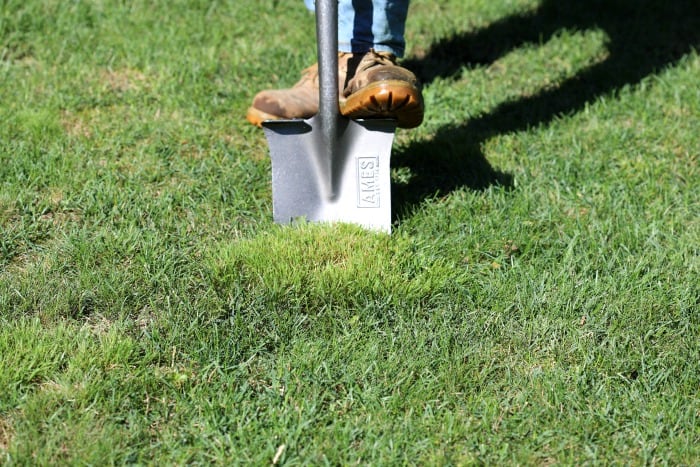
4. Spread Material
There are a few different options for spreading the material over your lawn. The most professional way, is to use a machine such as this Ecolawn Applicator. You could check your local rental place to see if they have a machine like this for rent. Of course you could also hire a local company to spread it for you if that is a local service companies provide.
It’s more likely however you’ll be doing this the manual way. Some people like to fill a wheelbarrow up with their material and then use a shovel to get the material out of the wheelbarrow. Once on the shovel they just fling the shovel and spread the material over the lawn. This is fine if just top dressing a small area.
But for larger projects you’re probably better off making a bunch of tiny piles throughout your lawn as shown below. Keeping the piles small will make it a lot easier to rake out later on and ensure that you are creating a thin layer.
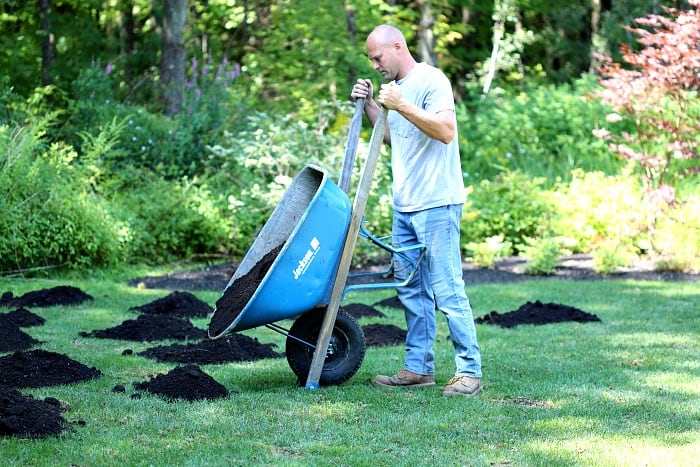
5. Rake In Piles
A leveling rake is the best and most professional tool for the job. Second best would be this aluminum landscape rake pictured below, but other garden rakes will work fine. Just take your time to rake out clumps and work the material into the lawn. Remember, you want a very thin layer so any grass that is being covered will be able to works its way up through the layer.
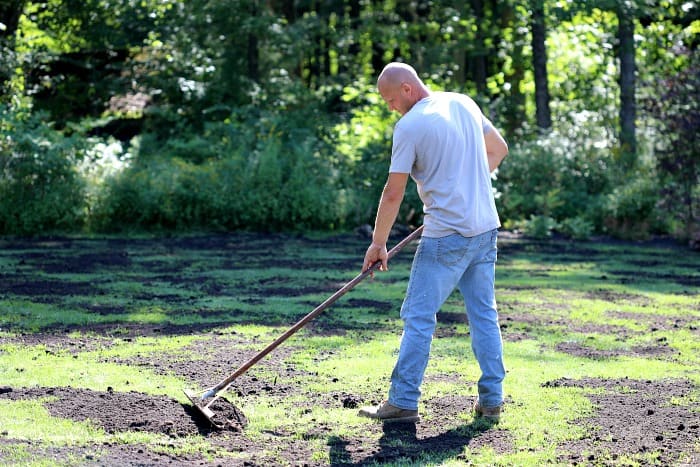
6. Apply Starter Fertilizer
Apply a slow release fertilizer such as Milorganite 6-4-0. A slow release fertilizer is ideal because it’ll slowly provide nutrients as seeds germinate.
When applying fertilizer use a good broad cast spreader and follow these steps to get an even application: How to Fertilize Your Lawn.
7. Apply Seed
After applying your starter fertilizer it’s time to apply your seed. Once again, use a broadcast spreader and follow the seed application rates on the seed label. Don’t over apply seed!
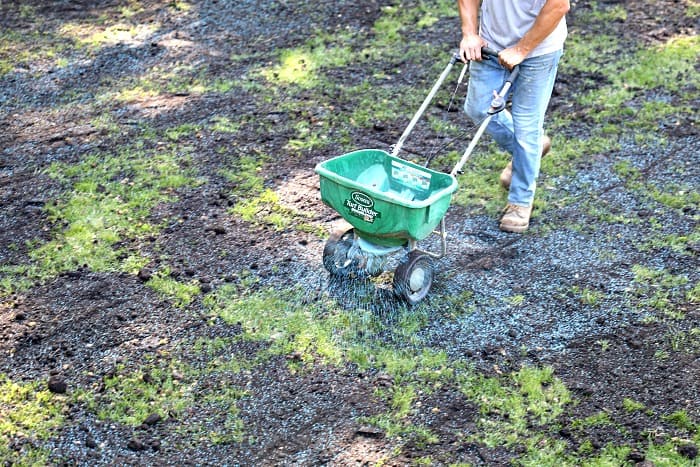
Do some research before just purchasing any bag of seed. With seed, you get what you pay for. Stay away from contractor mixes
GCI Seed is a great place to buy seed online. Scotts also has some great grass seed options that you can usually find in the big box stores.
8. Irrigate
Don’t forget to setup irrigation! If you don’t have an irrigation system then check out this battery operated irrigation controller. You can schedule them to come on multiple times a day.
You can set up to 4 zones per controller and get at least 2 sprinklers per zone. This will cover a lot of square footage and get you out of moving sprinklers all day.
The early to late summer weather can be unpredictable. Really hot days can pop up. Be sure to monitor the weather and plan for these hot days. New seed needs to be constantly damp to germinate.
Check Out These Posts Next
Follow Me
Join my free email list!
Plus, follow me on Facebook, Instagram, and Pinterest.


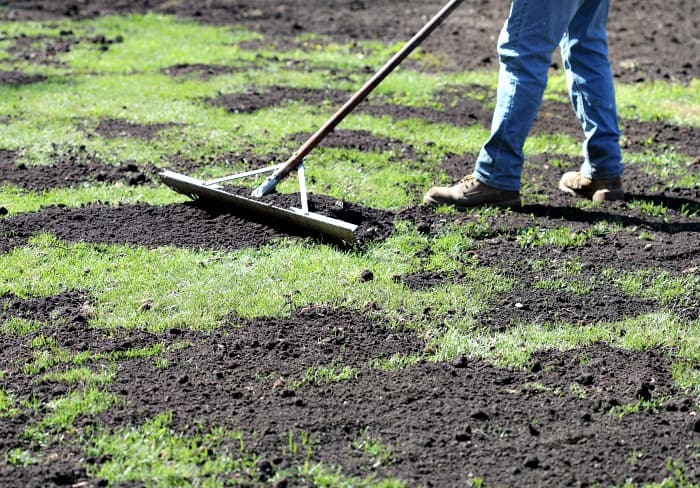
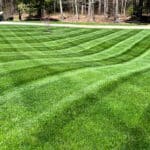
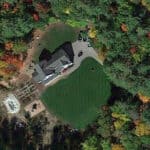
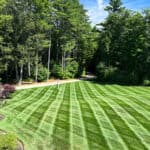

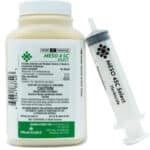
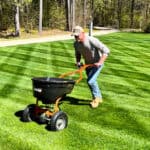
Great information! Thank you from Ga.
Anytime!
Which lawns would benefit from aeration and top dressing? Lawns that have a soil depth of four inches or more will benefit from this treatment.
All lawns can benefit from periodic top dressing and aeration, especially lawns that are in distress.
Which type of grass seed would you recommend for best growth in Colorado
Where in Colorado are you located?
Hi. I am in zone 7 in Upstate SC. I was planning to work on my yard and had planned on waiting until September. Would you agree with that time? Also, I’ve been searching for the info you provide here and it’s clear and helpful! Thank you.
Hi , glad you’ve been enjoying the info! You’re in that transition zone where some people have cool season grass while others have warm season grass. Assuming you have cool season grass such as kentucky blue, fescue, rye, I would say late september is good timing in your area. This is when cool season grasses thrive and broadleaf weeds start to wind down. Just keep an eye on the weather and make sure you’re not entering a stretch of hot dry weather. Once nights start cooling off it helps to reduce soil temps which triggers a boost of growth for cool season grasses.
I bought a compost spreader (drum 24×18″). Seemed to work pretty well – do you have any thoughts on that versus using a wheelbarrow and dropping in places?
Compost spreaders are awesome. Definitely saves time, energy, and does a great job of an even, thin spread. Most homeowners don’t have one so I recommend using a wheelbarrow but a compost spreader is definitely superior.
Hi, thanks for the article! I’m in zone 5 and my lawns basically just weeds and crabgrass, I’m too cheap to rip it up and sod so I was going to roundup everything, top dress with 1/2” and seed in sept/oct, then fertilize and irrigate in the Spring. Do you think I’m on the right track?
Hi Jarod, If you think you have all weeds with no viable turf, then yes you can use round up to kill everything. But you’d probably be better off renting a sod cutter to remove the weeds, add some loam over the area and re-seed. I agree sod can be expensive but if you can seed instead it wouldn’t cost that much more and you’d have much better results then top dressing over a bunch of dead crabgrass. Just a thought but good luck!
Hi Mark,
Thanks for posting the information. I am in Southern Maine and it is mid Sept. I generally aerate in the fall. My lawn could definitely benefit from top dressing and overseeding. Is it too late this year? Should I wait until spring?
Thanks for any insight!
Hi Todd, You should be fine as long as you get to it asap. At this point I would recommend overseeding with perennial rye, or fescue, or some kind of cool season mix. The mix can even contain kentucky blue but at this point I wouldn’t overseed with straight kentucky blue. It takes forever to get established and time is running out. Hope this helps thanks for your question!
my front lawn is slope and has two big maple trees and due to erosion, big roots are very visible and some are above the ground, is it okay to put a regular top soil to cover the roots and aerate and put a layer of compost then apply the seed?
Hi Mario, Yes I would definitely cover the roots, rake smooth and then apply seed. Stay away with the aerator because it sounds like the roots are shallow and the aerator could damage them. You might want to stick to a seed that is a little more shade tolerant since its under trees. This will help keep it established and hopefully prevent erosion moving forward.
We just had the lawn aerated and would like to overseed today. Frost is expected overnight and I wondered if I should wait a few days. The weather should be in the 50’s for the next few days with possible temperatures in the low 40’s overnight.
I wouldn’t worry about the frost effecting the seed. In fact some people use a strategy called frost seeding where they seed in very cold temperatures and the seed will germinate when the weather warms in the spring.
I have a very, very bumpy backyard. I get the lawn aerated every year. Is it better to use a roller on the lawn first, before trying to top dress? The lawn is heavy clay – would a pure compost top dressing work OK?
Though I don’t have a thatch problem I’ve also wondered about using a power rake to try and take out some of the high spots.
Any thoughts are appreciated!
Hi Steve! For a very bumpy yard with clay soil I would recommend core aerating and then top dressing with pure compost. For a very bumpy lawn you might have to repeat the process next year, but eventually you should be able to smooth it out a lot. I would stay away from rolling it, especially since you have clay soil. That will cause even more compaction. Instead core aerating and top dressing will help work compost into the soil and that will help considerably with drainage and compaction issues. As for power raking, if you don’t have a thatch problem then power raking isn’t going to do much. A power rake won’t move the earth around or do any kind of leveling. They are designed purely to remove thatch. Feel free to check out the link here if you’re not sure how to check for thatch problems: http://plantforsuccess.com/lawn-dethatching/ Overall, incorporating compost is the ultimate approach to clay soil management. Your idea of core aerating and top dressing with compost is the right way to go!
Thank you Mark. Starting to plan the spring yard work and this is handy to know.
You’re very welcome!
Great article. Exactly what I want to read. I have a mostly dead yard of mixed grass and weeds. I’m thinking of killing it all (chemical) and starting over using a thick top dressing of compost in min NC. Clay soil. Thinking mostly compost? Low maintenance can survive in part sun. Thinking zoysia?
Hi Kyle, before killing off the lawn chemically, I highly recommend looking into a sod cutter rental. They do such a neat job and you can scrape out the root system of the old lawn. People usually underestimate how much work is still left after killing their grass of with chemicals. You still have to get the dead grass, and ideally the root system out. Once all that is removed, I agree compost is a good choice. If you really wanted to amend the soil you could put a top layer of compost down and till it into the soil and then put a final layer of compost on top that just gets raked out. Also, I agree Zoysia sound like a good choice. Pretty low maintenance and tough. Is great in full sun but can handle some partial shade.
Thanks for the reply. Unfortunately a previous owner used sod years ago and left the layer of nylon netting that is now about an inch or so below the surface. I’m not sure how effectively I can use a sod cutter or tiller. I am also dealing with a lot of small corners and edges. Haha, it’s a mess. I’m not looking for perfect, the goal is to get something closer to grass and less wild strawberries.
I understand… then by all means try your top dressing approach. Another option is to spot spray or blanket spray the whole lawn with a product like Ortho Weed B Gone leading up to your lawn renovation. This will kill weeds but leave the desirable grass. Then you can top dress the whole lawn and seed. You’d be surprised how many disaster lawns I’ve turned around with this approach. Much better then nuking the whole lawn. Just a thought, hope that helps!
Thanks again. What are you thoughts on torching weeds/lawn? Might this be an alternative to chemical?
Honestly I don’t know too much about it but I know some people who do it. My understanding is you can burn your warm season lawn in late winter early spring right before its ready to come out of dormancy. This kills weeds and thatch but my understanding is the grass comes back and the char acts as a natural fertilizer. If you go down this route check locally to see if there are any restrictions on this due to safety.
How long after applying the weed killer can a top dressing be done? Will the selective herbicide loose effectiveness on broadleaf weeds that are covered by the top dressing?
Thanks!
Hi Paul, I would let the herbicide have three days to get soaked into the weeds before applying the top dressing. The weeds won’t be dead by then but they will be in the cells of the plant by then and will eventually kill them. At that point they shouldn’t be as disturbed by the top dressing and should die. Now, if you are going to apply seed I’d be extra careful since most herbicides require you to wait about 3 weeks after application to apply seed. Tenacity herbicide however, with the active ingredient Mesotrione can be used at the same time as seeding and will not effect germination of grass seed. That’s why it’s my go to herbicide whenever doing a seeding job.
Hello,
I just did a top dressing on my lawn of compost and half of my lawn has turned brown. Any tips I’m definitely confused on this one
Hi Josh, where are you located? It could be a number of different things, and could even be a temporary shock. If you spread the compost too thick it could suffocate existing grass. Also if the compost you put down is still breaking down it could be given off too much heat. feel free to provide some more info in terms of grass type and location and walk me through your process.
I’m in SE Wisconsin and I have a few problems. Bumpy lawn, lots of dandelions, some bare spots, and just had a new concrete driveway put in yesterday so that area needs grass. I do aerate spring and fall for the past 3 years. My big question is it okay to top dress right now?
Plus we have a puppy now, what’s the safest way to kill weeds and fertilize?
Hi Jamie… my favorite herbicide leading up to a renovation is Tenacity. Tenacity is non toxic to people and pets after the herbicide has dried. So as long as you can spray the weeds and let it dry for several hours you are safe! I prefer to wait until the fall for top dressing, especially now that we are getting near the summer season. If you have an irrigation system you should be fine to top dress now, otherwise you definitely need to make sure you set up sprinklers so you can water your newly top dressed lawn throughout the summer. You’ll see weeds pop up if you top dress now, but during the fall you can apply the Tenacity again. Eventually if you keep feeding the lawn the weeds grass will take over and the leads will be out competed. In terms of fertilizer, Milorganite 6-4-0 is made from bio solids and is almost completely organic. It’s not the best starter fertilizer though. I would use the 12-12-12 Starter Fertilizer by Yard Mastery (you can look up and order online). It is more safe than the pure synthetic fertilizers.
I am looking to do the full works soon on my lawn in Livingston Mt. Weed Killer, soil test, core aeration, overseed, fertilizer, top dress.
My question is if a soil test is performed how do you account for then added the nutrients of the compost to the lawn? Would the compost nutrients be negligible in the end and shouldn’t be factored into any other amendments to the soil?
Great question Derek… think of compost as being super slow release in terms of nutrients. Compost will increase microbial activity and supply a steady stream of nutrients to your lawn over time but in addition to it you need to use fertilizers that will deliver a quicker supply of nutrients. In terms of soil testing I would test your existing soil and then add compost. If you were to take a sample from the compost you wouldn’t be getting an accurate reading of your current soil conditions.
If the compost has small twigs in it, will that affect the lawn? I’ve screened some in the past but am looking at a bigger workload this time around.
Hello Mark, Your thoughts on using a roller after top dressing? I suspect that since we are only putting down a thin layer of top soil that using the roller is not necessary? With that said, if you are doing a new lawn from scratch would you always use a roller to finish the job? Thanks Charlie R.
Hello Mark would appreciate a reply to my question about when the best time is to use a lawn roller? This was the original question: Hello Mark, your thoughts on using a roller after top dressing? I suspect that since we are only putting down a thin layer of topsoil that using the roller is not necessary. With that said, if you are doing a new lawn from scratch would you always use a roller to finish the job? Thanks Charlie R.
Hi, I’m located in MN. I’m planning on topdressing this spring. I have a nice lawn but a lot of clay and thin roots. I purchased a commercial top dresser and I’m planning on ordering a clay soil amendment blend consisting of pine bark, organic compost, fibrous coarse peat and coarse sand. How early can I top dress in my climate and what rate would you recommend for healthy grass? The grass is still mostly brown and frost is probably 50% out. Thanks for any input!
Hi Chris, I would wait until soil temps are at a 5 day average of 50 degrees to pull the trigger on this. Grass seed won’t really germinate until 55 degrees. Monitor soil temps at Green Cast Online so you can be ready to go. I’d aim for an application rate of 1/4″.
Hello. I live in coastal NC with sandy soils and ground pearls are a problem. So I have some bare spots and with invasive Oxalis weeds around bare spots. I just had our lawn aerated 2 weeks ago. Can you advise me what should I do . My grass is zoysia empire and some areas are thin some are good. The grass is also slow in getting out of dormancy. Is sodding my best bet. I heard zoysia grass seeds are hard to grow? Thank you.
Hi Maria… If you have zoysia grass that is very thin, to the point where it is pretty much non existent I would either lay sod or plant zoysia plugs. You should be able to find both locally. However, if I you just have a thin lawn I would follow my lawn care plan for warm season grass here: https://plantforsuccess.com/lawn-care-program-warm-season-grass/…. You’d be surprised how much you can turn around a lawn just by feeding it and maintaining it correctly. Especially Zoysia since it spreads quickly. I would spot treat the weeds with a liquid, lawn safe, herbicide such as Atrazine.
Hey there Mark,
I have a North Texas (DFW area) yard with Bermuda grass, I think. It was sodded in clay when we purchased our home in 2018. Is clay bad for Bermuda grass? It’s been extremely difficult to get the grass to a completely green/healthy state having this soil type. Our lawn care service provider of 4 years cuts and fertilizes, but there hasn’t been any improvement. Is there a recommended grass type that performs better in clay? I had fescue before but the foundation was dirt/soil, not clay and it thrived. I loved the green of that yard. Now the only time I see green is when I look at my bushes. I agree aerating will be helpful, but I’m not sure which of the options you’ve provided will work best. What options and products do you recommend to use so I can get that golf course looking grass? I am not opposed to changing from Bermuda, but the may get costly. As James Brown begged “PLEASE! PLEASE! PLEASE!” Help my grass grow.
Hi Adrian, where you are located I would stick to Bermuda grass over Fescue. Honestly, Bermuda is one of the better choices for clay soil and it’s an aggressive spreader. That being said, if you have a very clay lawn there are things you should do to amend the soil. Top dressing with compost after core aeration is definitely one thing that could help. You can also use liquid aeration and apply some other products that will help break down the clay. Check out my post on growing grass in clay soil here: Clay Soil.
Hello Mark, I live and service lawns in a retirement complex in MA., and this year the drought conditions has been very difficult to deal with. Strict town watering bans are in place to the point that the water department actually came to each home and severed the inground water sprinkler systems. I kid you not! My customers beautiful lawns burnt to a crisp! So, now it is fall, right after Labor Day I was out aerolating and overseeding, used milorganite as a starter fertilizer. Waited 3 weeks, a total bust on all lawns. The same procedure that I used with huge success the year prior! Such a disappointment! Now, I am beginning to suspect that the burnt grass which is now technically thatch should have been roughed up and removed. I am also wondering is my Lesco weed and feed I used for 2 seasons may have negated the germination process even though Lesco says no! This Labor Day I am going to top-dress, seed and use starter fertilizer to bring back the lawns. Running out of time, this is my last hurrah for the season on lawn repair. Please, your thoughts and comments on everything I wrote about. Many thanks, Charlie R. PS: A article on how to deal with lawn care in drought conditions with be very beneficial!
What are your recommendations for mossy areas? Do I need to remove the moss before compost application?
I would do whatever you could to remove as much moss as possible. A firm raking, and core aeration will definitely help. Also what is the cause of your moss? Is it lack of sunlight or is it more of a poor drainage issue/neglected lawn issue. Core aeration and top dressing will definitely help with drainage and maintaining a healthy lawn will also block mulch from forming.
We built a new house 2 years ago in the Charleston SC area. The builder placed sod on top of the builder dirt/sand mixture. We’ve noticed some of our grass is growing well, but we have a lot of bare spots. What would you recommend to top dress the lawn?… I’m leaning towards compost, but would love advice from someone more knowledgeable.
Hi Miriam, I’m a big fan of compost for top dressing a lawn, especially one that has poor soil. I’m curious what type of grass you have. You could go a step further and core aerate, then top dress, and then seed or plant plugs depending on your grass type. That’ll help fill in those damage areas and will also help compost get deeper into the soil.
Sorry if this was already asked. My ph level is too low. For a long time I’ve just tried to work with it (after an unfortunate, diy, experience with too much lime) but I’m literally just throwing my money at my lawn with expensive products and seeds that aren’t really working bc the conditions stink. I plan on aerating and top dressing with compost this fall but before that I need to get some lime on the soil. Should I do this after aeration but before top dressing? Should I overseed at this point or wait until my ph improves? My plan over the next year or two is to really focus on soil health and not go crazy with trying to grow grass. Thank you for your time. I really appreciate the way you explain things.
Hi Dawn! So with adjusting ph levels, don’t forget it’s a gradual process. If your lawns soil is very acidic, than it may take several lime applications over a couple of years to really get the soil into the optimal range. Incorporating compost after aeration should definitely help in addition to regular lime applications. And yes, I would core aerate, apply lime, and then top dress. Usually after top dressing with compost I recommend seeding. I’m curious if you know the exact pH of your lawn? Also, where are you located? I’m curious if you have cool season or warm season grass. Thanks!
Hi, I have a soil test showing very high. 185 lbs per acre. I planned on aerating, adding compost and overseeding followed by a phosphorus free fertilizer. My soil is so compacted I wanted to topdress with lots of compost this fall to help drainage. I know I could just aerate alone but really wanted to start actually fixing the problem. Will the phosphorus in the compost hurt me in the end or will I be better off adding it anyway to help my compaction problem?
Hi Corey, I would definitely add the compost to your aerated soil, that takes precedent over having high phosphorus. Also for compacted soil I would work Liquid aeration into your routine a couple of times a year. Check this out: https://plantforsuccess.com/growing-grass-clay-soil/
When is it too late to top dress . I live in s,e Wisconsin.
Hi Christine! If you are planning on seeding then it’s too late. But if you’re just looking to amend the soil you can pretty much do that anytime as long as there is not frost and the top dressing material is workable.